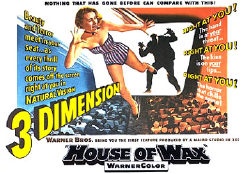
3D in depth riting about Avatar (which I see in the Guardian someone has
unkindly nicknamed 'Dances with Smurfs') in my previous post leads me to write about 3D in
general. 3D still photography goes back to Victorian times, of course, with the
Stereoscope (right), where side-by-side photos
would be viewed through lenses allowing the eyes to resolve them as one image:
the effect was highly convincing.
riting about Avatar (which I see in the Guardian someone has
unkindly nicknamed 'Dances with Smurfs') in my previous post leads me to write about 3D in
general. 3D still photography goes back to Victorian times, of course, with the
Stereoscope (right), where side-by-side photos
would be viewed through lenses allowing the eyes to resolve them as one image:
the effect was highly convincing. A similar process was still in use in relatively modern times with the Viewmaster (left) and various viewers designed
for use with stereo cameras (effectively two cameras side-by-side in the same
body).
A similar process was still in use in relatively modern times with the Viewmaster (left) and various viewers designed
for use with stereo cameras (effectively two cameras side-by-side in the same
body).As I wrote last April when reviewing Monsters vs Aliens, I first came across 3D in the 1940s when my parents bought a book of pictures using the red/green process - the two images placed in one but coloured red and green, with glasses to separate them for each eye - in order to find out whether I could actually see 3D as my eyesight was a bit problematic. I could, and was fascinated by the way objects could appear above the page and look as if you could slide your finger under them.  In 1951 they took me to the Festival of Britain site on London's South Bank,
and I amazed them by standing quietly in a queue for an hour (I was 9) to see
the stereo films at the 'Telekinema' (right). I've seen these since as
well: most of them were filmed with two 16mm cameras bolted side by side, and
look convincing except that as the camera lenses were more the 2.5 inches apart
(the average distance between the eyes) eveything appeared too small. The
process used Polaroid™
glasses to separate the images, which could thus
be in colour (and a lot less strain on the eyes then
red/green).
In 1951 they took me to the Festival of Britain site on London's South Bank,
and I amazed them by standing quietly in a queue for an hour (I was 9) to see
the stereo films at the 'Telekinema' (right). I've seen these since as
well: most of them were filmed with two 16mm cameras bolted side by side, and
look convincing except that as the camera lenses were more the 2.5 inches apart
(the average distance between the eyes) eveything appeared too small. The
process used Polaroid™
glasses to separate the images, which could thus
be in colour (and a lot less strain on the eyes then
red/green). In the 1950s there was a spate of 3D cinema
films, introduced as a competitor to television. There had been
various proposals and experiments in 3D cinematography going back some years -
some of them frankly loony (rotating shutters in front of the eyes, for example)
- but by this time the Polaroid system was pretty well standard. I've seen a
number of these films, including Kiss Me, Kate, House of Wax, Dial M for
Murder, and Miss Sadie Thompson - for the most part convincing,
though the last-named in particular made everyone look about four feet
tall.
In the 1950s there was a spate of 3D cinema
films, introduced as a competitor to television. There had been
various proposals and experiments in 3D cinematography going back some years -
some of them frankly loony (rotating shutters in front of the eyes, for example)
- but by this time the Polaroid system was pretty well standard. I've seen a
number of these films, including Kiss Me, Kate, House of Wax, Dial M for
Murder, and Miss Sadie Thompson - for the most part convincing,
though the last-named in particular made everyone look about four feet
tall.The fashion didn't last long: too many films spent too much time throwing things at the audiences, who soon got bored. There was also the eyestrain problem - with the images on two separate strips of film, image jiggling - though not immediately obvious to the viewer - placed a strain on the eye muscles to prevent double images. After only a few years it all petered out, though the odd film did emerge in later years in several different processes (most of them rubbish, and usually invovling even more eyestrain). Audience resistance to wearing glasses was another factor; and in the end CinemaScope, Cinerama and later Panavision won out. Now the threat is not so much just television as home cinema - particularly with huge high-definition sets and Blu-Ray disks available, why drag out to the cinema? Hence the emergence of the latest spate of 3D IMAX films - though most of the features are actually not shot in IMAX but digital 3D, to be printed to Panavision for general release or up to the large IMAX film for projection in the IMAX theatres. This latter in particular has provided very much steadier images: I found that watching Avatar for over two-and-a-half hours caused me no eyestrain at all.  So far the results have been very popular -
Avatar was sold out at the London IMAX (right) almost immediately - and
no-one seems to mind the glasses so far. Unfortunately many of the films, to
judge by the trailers, are still obsessed with roller-coaster-type rides and
chucking things at the audience: this may well eventually have the same effect
as before and put people off. Will it woo people away from their Blu-Rays? - the
jury is still out on that one. So far the results have been very popular -
Avatar was sold out at the London IMAX (right) almost immediately - and
no-one seems to mind the glasses so far. Unfortunately many of the films, to
judge by the trailers, are still obsessed with roller-coaster-type rides and
chucking things at the audience: this may well eventually have the same effect
as before and put people off. Will it woo people away from their Blu-Rays? - the
jury is still out on that one.Posted: Sat - January 2, 2010 at 10:34 AM by Roger Wilmut |
Quick Links
About Me:
Roger Wilmut XML/RSS Feed
MY PODCAST
Archives
Calendar
Blogroll
WEBRINGS
Statistics
Total entries in this category: Published On: Mar 11, 2016 05:00 PM |
||||||||||||||||||


